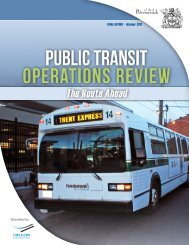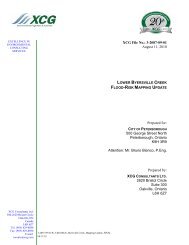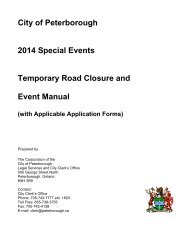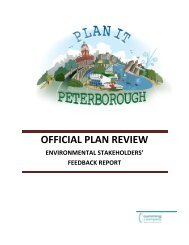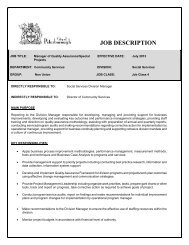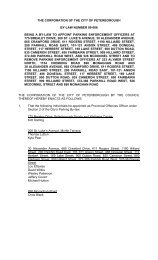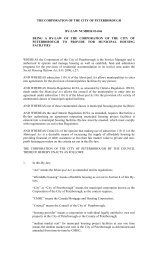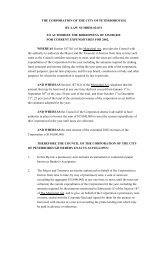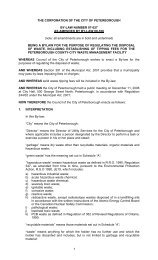Thompson Creek Flood Study Report - City of Peterborough
Thompson Creek Flood Study Report - City of Peterborough
Thompson Creek Flood Study Report - City of Peterborough
You also want an ePaper? Increase the reach of your titles
YUMPU automatically turns print PDFs into web optimized ePapers that Google loves.
<strong>Thompson</strong> <strong>Creek</strong> Detailed <strong>Flood</strong> Reduction <strong>Study</strong><br />
<strong>City</strong> <strong>of</strong> <strong>Peterborough</strong><br />
4.5.2.4 <strong>Thompson</strong> <strong>Creek</strong> Dam Flows<br />
All the storm event simulations previously described assumed a typical constant<br />
baseflow seepage rate <strong>of</strong> 0.1 m 3 /s from the <strong>Thompson</strong> <strong>Creek</strong> Dam. This is an<br />
appropriate assumption when dealing with local storms centred over the relatively small<br />
<strong>Thompson</strong> <strong>Creek</strong> watershed (approximately 75 hectares). The <strong>Thompson</strong> Bay on the<br />
upstream side <strong>of</strong> the dam is fed by the Otonabee River which has a drainage area in<br />
excess <strong>of</strong> 7,500 km 2 . At the time <strong>of</strong> year when local high intensity storms would occur,<br />
the Otonabee River would generally be at low levels and any local storm would have no<br />
effect on its flows. Hence it is unlikely that a large flow would occur at the dam<br />
simultaneously with the local flow in the <strong>Thompson</strong> <strong>Creek</strong> watershed.<br />
On the other hand, however, there is a potential flood risk in the <strong>Thompson</strong> <strong>Creek</strong><br />
watershed from a release <strong>of</strong> water from the <strong>Thompson</strong> <strong>Creek</strong> Dam itself. This could<br />
occur for a number <strong>of</strong> reasons, such as:<br />
<br />
<br />
<br />
high water levels on the Otonabee River during an extreme event might overtop<br />
the dam and cause high flows in <strong>Thompson</strong> <strong>Creek</strong><br />
during high flow periods on the Otonabee River, the Trent Severn Waterway<br />
(TSW), operators <strong>of</strong> the dam, may be forced to open the dam by removing some<br />
<strong>of</strong> the stop logs to release flow from <strong>Thompson</strong> Bay down <strong>Thompson</strong> <strong>Creek</strong><br />
under extreme conditions, a dam break might occur which would release high<br />
flows down <strong>Thompson</strong> <strong>Creek</strong>. There is no evidence that such an occurrence is<br />
likely to happen but it is a potential scenario which should be considered.<br />
It is not feasible to predict the probability <strong>of</strong> the above events because they involve<br />
various human interventions which may or may not occur in different circumstances.<br />
However, in order to understand the implications <strong>of</strong> such situations, two simulations<br />
were completed to identify the flows which might occur in <strong>Thompson</strong> <strong>Creek</strong> and the<br />
possible water levels and extent <strong>of</strong> flooding that might occur. The first scenario<br />
involved removing 3 stop logs from the dam. This might be equivalent to the second<br />
type <strong>of</strong> situation described above. The second scenario involved removing 7 stop logs<br />
from the dam. This might be considered to be equivalent to the third situation where a<br />
breach <strong>of</strong> the dam occurred. In both cases there would be a sudden release <strong>of</strong> water<br />
from the dam with the latter being much larger.<br />
The Visual OTTHYMO model was used to simulate the flows which would occur in<br />
<strong>Thompson</strong> <strong>Creek</strong> in these two situations. It was assumed that the water level in<br />
<strong>Thompson</strong> Bay would remain constant since there is a large volume <strong>of</strong> water in that<br />
system. This effectively generates a constant outflow which is then routed downstream.<br />
14-06605-01-W01 <strong>City</strong> <strong>of</strong> <strong>Peterborough</strong> 64




